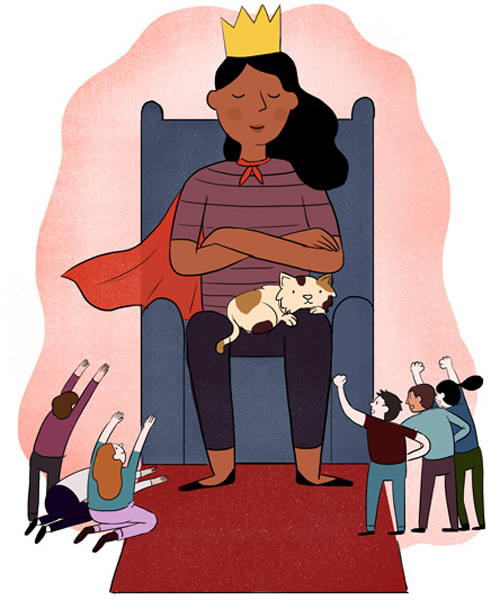Getting off shaky ground
How to regain your balance and grow past founder’s syndrome

Looking back now, the red flags were painfully obvious. But I was naïve and idealistic, so when an acquaintance asked me to be on the board of directors for a new rescue group he was starting, I jumped at the opportunity. Never mind that board positions were determined in the same manner one calls for “dibs” on the front seat, or that the bylaws allowed board members to kick others off for no reason with a simple majority—this was my chance to start working in the animal welfare field!
Those grandiose plans were quickly shattered when I realized the founder was using the group to publicly and vociferously trash the major players in the local animal welfare community. Wanting to keep my name out of the fray, I tried to keep my association with the rescue group under wraps, but when I started getting angry emails from the founder because he didn’t think I was posting about the organization frequently enough on Facebook, I knew it was time to move on. Not surprisingly, many years later, that rescue seems to have turned into a one-man band instead of the powerhouse we’d hoped to be.
While the details of my story may be uncommon, the end result isn’t. What I didn’t know at the time is that I was experiencing a common governance issue known as founder’s syndrome, which happens when a founder or other leader exerts absolute control over the organization. Whether it’s an executive director to whom everyone in the organization always acquiesces, a bad apple who causes gridlock on the board of directors or a founder who rebuffs staff members’ suggestions to try any new policies, founder’s syndrome is a near-universal problem in the rescue world. It’s not unique to rescue groups—and luckily, there are ways to get your organization successfully through it.
Checks and Balances
According to Addie Nelson Backlund, principal of the eponymous nonprofit consulting firm outside New York City, the problem occurs when one person (usually, but not always, the founder) has an imbalance of power in the organization. The executive director who also serves as chair of the board of directors (and therefore, acts as her own boss), the founder who has to personally approve every single adoption, the 10-year-old agency that hasn’t been able to grow its financial model past the startup stage—yep, those are all signs that your organization is going through founder’s syndrome, says Backlund. And when it happens, it’s usually more a problem with the organizational infrastructure than any one person.
Founder’s syndrome often pops up in organizations that haven’t adhered to governance best practices. The ideal corporate structure is set up in a way that each level serves as a check on the other. The board sets the strategic direction, and the executive director carries it out. The executive director is accountable to the board, while the board gives the director the space to lead. But no one person runs the show.
Just about every nonprofit organization goes through founder’s syndrome at some point. Nonprofit organizations have a natural lifecycle, Backlund explains. During the startup phase, the founder is often the person who does everything, including filing the incorporation documents, building a board of directors, fundraising, creating a strategy, delivering services and many other steps to get the organization up and running. But Backlund says that has to change once the organization is operating on firm ground—“at some point, there’s going to be a gap between what the founder is capable of and what the organization needs.”
Tom McLaughlin, founder of McLaughlin and Associates, a nonprofit consulting firm in Andover, Mass., notes that founder’s syndrome is usually about the interaction between the board of directors and the founder. What’s often lost on small organizations, McLaughlin explains, is that the board of directors needs to be accountable to its supporters and donors, not to the executive director—and executive directors report to their boards. But many people who agree to be on a board don’t fully understand what their role and responsibilities are, so when an executive director with a forceful personality starts telling board members what to do, many times they don’t even realize that the executive director is out of line.
This is something that Sandy Rees, founder of the nonprofit consulting firm Get Fully Funded in Loudon, Tenn., sees all the time. “An awful lot of people are serving on boards without knowing what that means,” she says. “And people [are] recruiting for boards without understanding what should be involved. You can get a founder who is just asking random people to come join the board, without any guidance or direction, and those people don’t really know what they’ve said yes to.”
Prevention Is the Best Defense
Another reason founder’s syndrome is so prevalent, McLaughlin says, is that founders are understandably protective of the organization they built. They may find it hard to trust others to do the work “right,” and this often manifests as an issue of control. Whether it’s a founder who micromanages everyone’s work or doesn’t plan for succession, a single person asserting control over all tasks is likely to become the organization’s downfall.
But there are things that founders can do to prevent this scourge from taking hold of the organization.

Rachel Mairose, founder and executive director of Secondhand Hounds in Eden Prairie, Minn., took pains when starting her organization in 2009 to avoid the common pitfalls. After working with some rescues that weren’t being run like businesses, Mairose had an idea of what she was trying to avoid. “There was a lot of drama,” Mairose notes.
After the first couple of years, once the organization was on steady ground, Mairose made a deliberate effort to shift the board of directors from her friends and family to more strategic choices. An attorney here, a CPA there, a marketing guru everywhere. Mairose finds that it’s crucial to consider the type of person that will be a valuable asset for the strategic direction of the organization and not simply renew a member’s place on the board because the person has been there since the beginning. Consider people with a viewpoint different from your own, Mairose suggests. “Otherwise, if you’re surrounding yourself with people who always agree with you, what’s the point?”
Backlund finds that having written policies and procedures for governance issues is critical for clarifying the balance of power in an organization. For example, at board meetings, someone needs to take meeting minutes, document them, lay out the next steps, decide who’s taking the steps, circulate the minutes for review and go over them briefly at the beginning of the next board meeting so that everyone agrees they’re on the same page. Meetings should have an agenda and an end goal. There should be a nominating committee and a nominating process for the board. Make sure there are individuals at planning meetings who understand where the organization is heading.
These processes put mechanisms in place so that instead of having to confront someone you don’t believe is doing his or her job well, you can follow written, agreed-on protocols and remove someone who is underperforming according to standardized, unbiased metrics. Everyone’s tired of that jerk who’s always stirring up trouble at board meetings? Good news: According to the bylaws, board members cycle off after a two-year term, so you can stop trying to think of sneaky ways to force the person off. Concerned about a lack of solid accounting of the organization’s finances? Instead of relying on the person who volunteered to handle finances because she’s good with Excel, you can recruit a CPA to the board. “When you’re dealing with sensitive or uncomfortable issues,” Backlund says, “it’s the processes that can save you.”
Mirror, Mirror on the Wall
“All right,” you think, “this is all nice to know, but it doesn’t apply to my rescue, which is doing great.” Not so fast, says Rees. There are some questions that all founders of nonprofit organizations need to consider to ensure they’re going down the right path:
Am I willing to trust other people to get the work done? Do other people in the organization have authority to make decisions, or does everything have to be run by me?
This one goes back to the issue of control. “It is a red flag if the executive director has his hand in everything,” says Backlund. “An organization can’t grow without decentralizing.”
Heather Duren Stubbs, a longtime staff member at Columbia Second Chance in Columbia, Mo., knows this all too well. Columbia Second Chance had gone through the typical problems with founder’s syndrome (a founder exerting absolute control over the organization’s processes, policies, board of directors and finances), but came out the other side stronger than ever and mended the relationship with the founder. Stubbs credits building a strong organizational infrastructure and decentralizing control as key to getting them through.
“Structure is really, really important,” Stubbs notes. “To add those checks and balances was the thing that really got us off the ground.” Stubbs found that creating various committees, each with an independent leader, and adding volunteers to branch out into the necessary subcommittees, enabled the organization to grow in a healthy direction. The decentralized structure allowed people to hone in on an aspect of the organization they were passionate about and elevated the organization to the next level.
If I were hit by a bus today, what would happen to my organization?
There’s a reason this oldie-but-goodie has become a workplace cliché: It’s a great way to gauge your organization’s preparedness for the leader’s eventual departure. You want your organization to be around for the long haul, but if the founder is the only person with authority to write checks or is the only one who has access to the organization’s standard operating procedures, that doesn’t bode well for the organization’s longevity.
Moving Forward
Founder’s syndrome isn’t easy to get past. Many organizations with the affliction end up losing their supporters and eventually petering out, and McLaughlin finds that it can take years for an organization to get through the issues. And it often requires having difficult conversations with board members and staff. Like everything else in the animal welfare and protection field, this isn’t for the faint of heart.

But Backlund finds that confrontation isn’t necessarily needed to resolve founder’s syndrome. There’s a reason “best practices” are labeled as such: By implementing them, you’re putting strong infrastructure in place that allows the checks-and-balances mechanism of corporate structure to do its job. In other words, Backlund says, when you refer to best practices for governance, “it takes away the personalization. You’re not blaming the founder; instead it’s putting in place the stuff that the organization should be doing.”
Rees agrees, noting that “board best practices help prevent or provide a way through founder’s syndrome.” When developing your own procedures, consider bringing in a mediator or consultant to help you compare your operations to best practices (see p. 39). Having that neutral party evaluate your structure and help you implement best practices can take away the sting of any perceived blame and set the organization on the path to success.






